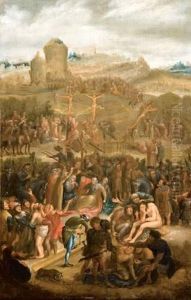Lucas Franchoys Paintings
Lucas Franchoys the Younger was a Flemish Baroque painter born in the city of Mechelen, in what is now Belgium. His exact birth date is not firmly established, but he was baptized on April 3, 1616. He came from an artistic family; his father, Lucas Franchoys the Elder, was a painter, and his brother, Peter Franchoys, was also involved in the arts. Lucas the Younger is primarily known for his portrait work and religious compositions.
Franchoys received his initial training from his father, which was customary for the time. He may have also studied under the prominent artist Peter Paul Rubens in Antwerp, although direct evidence of this apprenticeship is lacking. Nevertheless, Franchoys' style was clearly influenced by Rubens, evident in his use of dynamic composition and a rich, vibrant palette.
After his training, Lucas Franchoys the Younger worked in Mechelen and quickly gained a reputation for his skill. His portraits are characterized by their elegance and attention to detail, often capturing the social status and personality of his subjects. He also painted altarpieces for churches, where his ability to depict biblical scenes with emotional depth and drama was well received.
Franchoys' work was appreciated not only in his hometown but also in surrounding regions. He received commissions from various religious institutions and members of the nobility throughout the Southern Netherlands. Despite his success, there is a relative scarcity of information on his life compared to other artists of his caliber, which may be partly due to the overshadowing fame of contemporaries like Rubens and Anthony van Dyck.
Lucas Franchoys the Younger continued to paint until his death in 1681 in Mechelen. His contributions to Flemish art are not as widely recognized today, but his paintings remain a testament to the rich artistic environment of the 17th-century Southern Netherlands. His works can be found in several museums, churches, and private collections, where they continue to be studied and appreciated for their craftsmanship and historical value.

